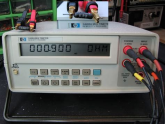gnubie
Solar Wizard
- Joined
- Sep 20, 2019
- Messages
- 3,847
Put 12A through that (if you're in the 120V world) and you get 19 mV/foot. Outlets 5' apart would be 100 mV different.
A good an idea as that is, mains voltage stability would likely swamp the difference making it hard to tell if the meter had been moved 5' or 5 miles (ok, slight exagfgeration




